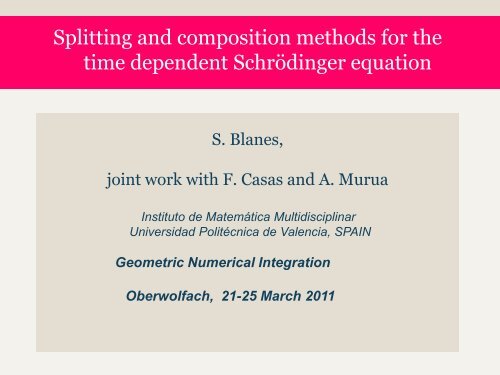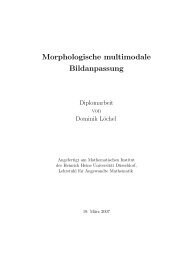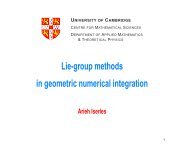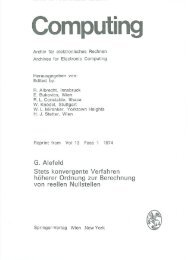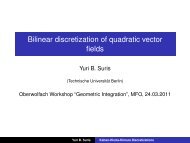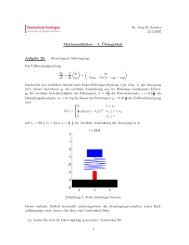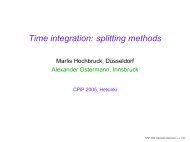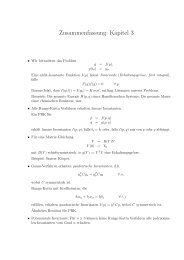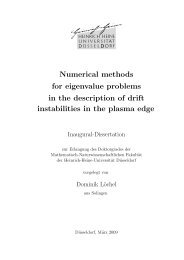The Symplectic Splitting Method
The Symplectic Splitting Method
The Symplectic Splitting Method
Create successful ePaper yourself
Turn your PDF publications into a flip-book with our unique Google optimized e-Paper software.
<strong>Splitting</strong> and composition methods for the<br />
time dependent Schrödinger equation<br />
S. Blanes,<br />
joint work with F. Casas and A. Murua<br />
Instituto de Matemática Multidisciplinar<br />
Universidad Politécnica de Valencia, SPAIN<br />
Geometric Numerical Integration<br />
Oberwolfach, 21-25 March 2011
<strong>The</strong> Schrödinger equation<br />
We consider different families of Geometric Integrators for solving the SE<br />
<strong>The</strong> solution of the discretised autonomous equation is given by<br />
where c = (c 1,…, c N) T C N and H = T + V R N×N Hermitian matrix.<br />
Fourier methods are frequently used<br />
is the fast Fourier transform (FFT)
<strong>The</strong> <strong>Method</strong>s Considered<br />
I - If the solution is not smooth: methods which involve products H c<br />
Polynomial approximations to the action of the exponential on a vector<br />
1 – Taylor<br />
2 – Chebyshev<br />
II - If the solution is smooth: to split H=T+V<br />
3 – <strong>Splitting</strong> (real + imaginary parts)<br />
High-order <strong>Splitting</strong>-decomposition methods (with possible complex<br />
coefficients)
<strong>The</strong> <strong>Method</strong>s Considered<br />
I - If the solution is not smooth: methods which involve products H c<br />
Polynomial approximations to the action of the exponential on a vector<br />
1 – Taylor<br />
2 – Chebyshev<br />
3 – <strong>Splitting</strong> (real + imaginary parts)
<strong>The</strong> <strong>Method</strong>s Considered<br />
I - If the solution is not smooth: methods which involve products H c<br />
Polynomial approximations to the action of the exponential on a vector<br />
1 – Taylor<br />
2 – Chebyshev<br />
3 – <strong>Splitting</strong> (real + imaginary parts)<br />
If we consider the following problems are equivalent<br />
or, in short: z’ = M z with z = (q,p) T
<strong>The</strong> Taylor <strong>Method</strong><br />
An m-stage Taylor method to approximate<br />
where is the Taylor expansion of the exponential, which<br />
approximates the exact solution up to order m
<strong>The</strong> Taylor <strong>Method</strong><br />
An m-stage Taylor method to approximate<br />
where is the Taylor expansion of the exponential, which<br />
approximates the exact solution up to order m<br />
We can advance each step by using the Horner's algorithm<br />
This algorithm can be trivially rewritten in terms of the real vectors, and it<br />
only requires to store two extra complex vectors (four real vectors).
<strong>The</strong> matrix that propagates the numerical solution can be written as<br />
where the entries T1(y) and T2(y) are the Taylor series expansion of cos(y)<br />
and sin(y) up to order m, i.e.<br />
Notice that<br />
<strong>The</strong> eigenvalues are given by<br />
<strong>The</strong> scheme is stable if<br />
<strong>The</strong> Taylor <strong>Method</strong><br />
For practical purposes, we require however
<strong>The</strong> Chebyshev <strong>Method</strong><br />
<strong>The</strong> Chebyshev method approximates the action of the exponential on the<br />
initial conditions by a near-optimal polynomial given by:<br />
where<br />
with Here, Tk(x) is the kth Chebyshev polynomial<br />
generated from the recursion<br />
and T0(x)=1, T1(x)=x. Jk(w) are the Bessel functions of the first kind which<br />
provides a superlinear convergence for m > t r(H ) i.e.
<strong>The</strong> Clenshaw algorithm allows to compute the action of the polynomial by<br />
storing only three vectors<br />
which can also be easily rewritten in term of the real vectors and it only<br />
requires to store six real vectors. <strong>The</strong> scheme can be written as<br />
As in the Taylor case:<br />
It is not a symplectic transformation.<br />
<strong>The</strong> Chebyshev <strong>Method</strong>
Taylor order tol=inf tol=10 -8 tol=10 -4<br />
10. 0. 0. 0.<br />
15. 0.111249 0.111249 0.111249<br />
20. 0.164515 0.164515 0.164515<br />
25. 0. 0.065246 0.065246<br />
30. 0. 0.108088 0.108088<br />
35. 0.0461259 0.138361 0.322661<br />
40. 0.0804521 0.160884 0.321618<br />
45. 0. 0.178294 0.320804<br />
50. 0. 0.192154 0.32015<br />
Chebyshev order tol=inf tol=10 -8 tol=10 -4<br />
20. 0.00362818 0.321723 0.643217<br />
25. 0.00233368 0.384289 0.64029<br />
30. 0.00162599 0.425648 0.638324<br />
35. 0.00119743 0.45502 0.636912<br />
40. 0.000918402 0.476957 0.63585<br />
45. 0.000726646 0.635021 0.635021<br />
50. 0.000589228 0.634356 0.634356<br />
55. 0. 0.633812 0.633812<br />
60. 0. 0.633357 0.633357
<strong>The</strong> <strong>Symplectic</strong> <strong>Splitting</strong> <strong>Method</strong><br />
Taylor and Chebyshev methods consider vector-matrix products to<br />
approximate<br />
A first order approximation<br />
can be written with<br />
or
<strong>The</strong> linear time dependent SE<br />
with H real and can be reformulated using real variables as the<br />
Hamiltonian system:<br />
with formal solution:<br />
<strong>The</strong> <strong>Symplectic</strong> <strong>Splitting</strong> <strong>Method</strong>
We have built splitting methods for the harmonic oscillator!!!<br />
<strong>Splitting</strong> method<br />
We have<br />
<strong>The</strong> <strong>Symplectic</strong> <strong>Splitting</strong> <strong>Method</strong><br />
which are polynomials of degree twice higher as in the previous cases for<br />
the same number of stages.
<strong>The</strong> <strong>Symplectic</strong> <strong>Splitting</strong> <strong>Method</strong><br />
<strong>The</strong> algorithm: a generalisation of the Horner's algorithm or the<br />
Clenshav algorithm<br />
It only requires to store one additional real vector of dimension<br />
<strong>The</strong> methods preserve symplecticity by construction:<br />
Stability: M is stable if |Tr K|
<strong>The</strong>orem: Any composition method is conjugate to an orthogonal method,<br />
and unitarity is preserved up to conjugacy.<br />
<strong>The</strong>re is a recursive procedure to get the coefficients of the splitting<br />
methods from the coefficients of the matrix K.<br />
We can build different matrices with:<br />
- Large stability domain<br />
<strong>The</strong> <strong>Symplectic</strong> <strong>Splitting</strong> <strong>Method</strong><br />
- Accurate approximation to the solution in the whole interval (like<br />
Chebyshev)<br />
- <strong>Method</strong>s with different orders of accuracy and very large number of<br />
satges.
Error bounds:<br />
<strong>Splitting</strong> <strong>Method</strong>s: valid for
with<br />
Initial conditions<br />
Schrödinger equation with a Poschl-Teller potential
LOG(ERROR)<br />
0<br />
-2<br />
-4<br />
-6<br />
-8<br />
-10<br />
-12<br />
Poschl-Teller potential<br />
Taylor: 10-40<br />
-14<br />
3.1 3.2 3.3 3.4 3.5 3.6 3.7 3.8 3.9 4 4.1<br />
LOG(FFT CALLS)
LOG(ERROR)<br />
0<br />
-2<br />
-4<br />
-6<br />
-8<br />
-10<br />
-12<br />
Poschl-Teller potential<br />
Split: 4-12<br />
-14<br />
3.1 3.2 3.3 3.4 3.5 3.6 3.7 3.8 3.9 4 4.1<br />
LOG(FFT CALLS)
LOG(ERROR)<br />
0<br />
-2<br />
-4<br />
-6<br />
-8<br />
-10<br />
-12<br />
Poschl-Teller potential<br />
Chebyshev: 20-100<br />
-14<br />
3.1 3.2 3.3 3.4 3.5 3.6 3.7 3.8 3.9 4 4.1<br />
LOG(FFT CALLS)
LOG(ERROR)<br />
0<br />
-2<br />
-4<br />
-6<br />
-8<br />
-10<br />
-12<br />
Poschl-Teller potential<br />
New Split<br />
-14<br />
3.1 3.2 3.3 3.4 3.5 3.6 3.7 3.8 3.9 4 4.1<br />
LOG(FFT CALLS)
References<br />
SB, F. Casas, and A. Murua, Work in Progress.<br />
Group webpage: http://www.gicas.uji.es<br />
SB, F. Casas and A. Murua, <strong>Symplectic</strong> splitting operator methods for the<br />
time-dependent Schrödinger equation, J. Chem. Phys. 124 (2006)<br />
234105.<br />
SB, F. Casas and A. Murua, On the linear stabylity of splitting methods,<br />
Found. Comp. Math., 8 (2008), 357-393.<br />
SB, F. Casas and A. Murua, Error analysis of splitting methods for the<br />
time-dependent Schrödinger equation, Submitted.
<strong>The</strong> Schrödinger equation<br />
II - If the solution is smooth: to split H=T+V<br />
High-order <strong>Splitting</strong> methods<br />
but the computation using FFTs is:<br />
<strong>The</strong> computational cost is independent if the coeficients are real<br />
or complex but, the coefficnets a i must be real because D T is an<br />
unbounded operator.
<strong>Splitting</strong> methods with complex coefficients
<strong>Splitting</strong> methods with complex coefficients
<strong>Splitting</strong> methods with complex coefficients<br />
SB, Casas, Chartier, and Murua, <strong>Splitting</strong> methods with complex coefficients for<br />
some classes of evolution equations. Submitted. arXiv:1102.1622v1
LOG(ERROR)<br />
-1<br />
-2<br />
-3<br />
-4<br />
-5<br />
-6<br />
-7<br />
-8<br />
A simple example: the Lotka-Volterra problem<br />
-9<br />
3.8 4 4.2 4.4 4.6 4.8 5 5.2<br />
LOG(EVALUATIONS)<br />
S 7 6R<br />
S 7 6C<br />
4 S 7 6C
<strong>Splitting</strong> for perturbed systems<br />
Additional benefits of the unitary splitting: It allows different ways to splitt<br />
depending on the structure of the problem
<strong>Splitting</strong> for perturbed systems<br />
Additional benefits of the unitary splitting: It allows different ways to splitt<br />
depending on the structure of the problem
<strong>Splitting</strong> for perturbed systems<br />
Additional benefits of the unitary splitting: It allows different ways to splitt<br />
depending on the structure of the problem<br />
This result can be generalised to the explicitly time-dependent case:<br />
P. Bader and SB, Fourier methods for the perturbed harmonic oscillator in linear<br />
and nonlinear Schrödinger equations. Phys Rev. E. In press.
Conclusions<br />
<strong>Splitting</strong> methods are powerful tools for numerically solving the<br />
Schrödinger equation<br />
Some a priori knowledge of the problem and its solution is essential<br />
for an efficient integration<br />
<strong>The</strong> performance strongly depends on how the system has been<br />
split as well as on the choice of the appropriate method for each<br />
problem<br />
<strong>Splitting</strong> methods with complex coefficients could lead to very<br />
efficient methods for many problems


